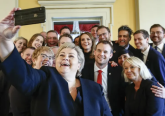 So June 5, Wisconsin’s Republican Governor Scott Walker beat his Democratic challenger Tom Barrett 53-46 in a expensive, hard-fought, and divisive recall election that gives a taste of what the fall general election will have to offer in swing states around the United States.
So June 5, Wisconsin’s Republican Governor Scott Walker beat his Democratic challenger Tom Barrett 53-46 in a expensive, hard-fought, and divisive recall election that gives a taste of what the fall general election will have to offer in swing states around the United States.
Here are three observations about money and where it comes from, about television versus field, and about the role of the internet that will also apply as Obama and Romney face each other—
First, this was a very expensive election and both candidate campaigns were heavily reliant on various forms of outside allies. According to the Wisconsin Democracy Project and the Center for Public Integrity, the Walker campaign spent $29.3 million and outside pro-Republican groups a further $18 million. Barrett spent $2.9 million, a tenth of the incumbent, and outside groups supporting him, many of them labor unions spent a further $15.5 million. Total expenditures equaled $65.7 million, or $26.2 per vote cast, up more than 50% from $37.4 million or $17.3 per vote cast in the 2010 gubernatorial election between the same two men. Most of the money, especially for the Walker campaign and the outside groups, came from out-of-state donors.
Second, both campaigns worked intensely to use all means at their disposal, whether advertising, spin, or volunteers talking to voters. Some commentary has cast the recall election as “TV ad spending vs. boots on the ground”, which certainly reflects Walker and his allies’ almost 3-1 edge in the money race but also an effort by Barrett and his allies to spin their financial inferiority into a compelling narrative of people vs. power. Both campaigns spent millions on television, and both campaigns mobilized thousands of volunteers to make millions of phone calls and door knocks to sway the undecided, shore up support from their base, and turn out their voters. (The news coverage suggests Barrett with his labor allies had an edge on the ground, but Walker certainly also had his own field operation running and some numbers suggest they’ve contacted more than 60% of all registered voters in the state at least once in person.)
Third, on both sides, we’ve also seen signs of new digital tools being battle-tested in advance of the fall general election. TechPresident reports that the Obama campaign tested their new “Dashboard” system to let volunteers from around the country make calls into Wisconsin, the AFL-CIO has trialed software that matches voter lists with volunteers’ Facebook friends to let them call targets that they actually know rather than total strangers, and the Walker campaign combined VoIP with digital voter files to automate the connection between identification calls and data entry. More “mundane tools” like email, websites with information about when and where to vote, and of course Facebook pages set up by volunteer groups or lower-level candidates themselves were also integral to the campaigns everywhere. As is the case elsewhere, the internet was not only a separate platform for a digital advertising and marketing strategy directed at voters, but also an infrastructure used for a lot of other campaign operations like fundraising and mobilization.
So the Wisconsin recall election was expensive, it involved campaigns heavily dependent on outside allies and grassroots help as they mixed and matched old and new forms of political communication, and it saw various internet tools used both to promote each candidate’s message online, but also as integral to more back-end operations rarely visible from the outside.
All this will be the case in the fall too when the vastly bigger and more complicated Obama and Romney campaigns and their many allies square off for the Presidential Election, drawing on money and manpower from around the country but focusing their efforts on a dozen or so swing states.
My book, Ground Wars: Personalized Communication in Political Campaigns, deals with how American political campaigns mobilize, organize, and target their field operations, using large numbers of volunteers and paid part-timer workers to contact voters at home at the door or over the phone. It has been published by Princeton University Press and is available on Amazon.
(cross-posted to rasmuskleisnielsen.net)
(image from the Barret campaign’s Flickr stream)







1 Comment